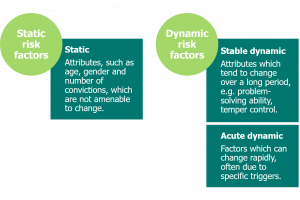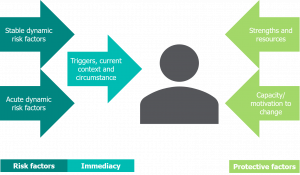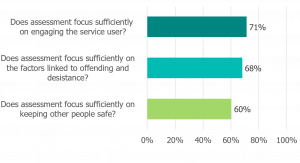Assessment

Key findings
- Structured assessment tools have been found to produce more accurate predictions of reoffending than unstructured professional judgement.
- A rounded assessment needs to pay attention to an individual’s risks, needs and strengths.
- To build a rounded view of the individual, a diverse range of sources of information should be utilised. Wherever possible, the service user should be meaningfully involved in their assessment.
- Engaging the service user in the process of assessment helps to build the one-to-one trusting personal relationships which can be a powerful vehicle for change.
Background
There are a number of technical requirements for assessment tools – they should be reliable (consistent between assessors), valid (identifying the most relevant risks and needs), sensitive (to change), and predictive (of future reoffending). There are further desirable characteristics from a practitioner perspective, including face validity (so that it is clear why each item is included), a simple scoring system, provision of evidence boxes, service user input, and completion within limited time constraints. Importantly, all assessment tools should be continually developed, ensuring that they reflect developments in the underlying evidence-base and changes in reoffending patterns, while continuing to support practitioners and current operational priorities and practices.
There have been four broad historical waves of probation service user assessment:
- first generation (1900 – 1970s) assessment was based upon unstructured practitioner judgement. The unstructured approach has been found to be of relatively poor predictive value, being subject to biases and inconsistency. As such, this approach can lead to poor planning and implementation of interventions
- second generation (1970s – 1990s) assessment uses actuarial scales. The actuarial approach is data driven and can perform well in terms of predictive validity. However, most actuarial approaches do not indicate the nature, severity and imminence of reoffending nor predict risk after treatment
- third generation (1990s – 2000s) tools incorporate dynamic risk assessment. Factors amenable to change such as lifestyle, employment, accommodation, attitudes, cognitive deficits, self-regulation and behaviours are considered. This more holistic, personalised and analytical approach to assessment, alongside actuarial predictors, helps with sentence planning and selecting appropriate interventions
- fourth generation (current) assessment tools are more systematic and comprehensive. They are explicitly founded upon the Risk-Need-Responsivity (RNR) principles. Fourth generation tools integrate elements of case management, such as intervention planning and implementation along with monitoring and review.
Nowadays, there are a plethora of assessment tools, reflecting the diversity of offending and service users. There are general assessment tools and specialist ones (such as those for sexual offenders, domestic violence perpetrators, extremists, or for the various forms of mental illness and learning disability). There are also general psychological assessment tools in use in criminal justice settings.
The main probation assessment tool currently in use in England and Wales is the Offender Assessment System (OASys), which was initially developed in 2001, building upon the existing ‘What Works’ evidence base. OASys provides a standardised assessment of the needs and risks of service users which, once identified, can be used to develop and deliver sentence plans. Within OASys, the following eight factors are scored as criminogenic needs: accommodation; education, training and employment; relationships; lifestyle; drugs misuse; alcohol misuse; thinking and behaviour; and attitudes.
Summary of the evidence
Evaluating predictive validity
In line with findings from other disciplines, structured assessment tools have been found to produce better predictions of reoffending than unstructured professional judgement – with the latter being prone to some biases and inconsistencies. This has been found to be true even for most rare and highly harmful offences – analysis of OASys and proven reoffending data has been used to produce separate predictors of general, violent and sexual reoffending.
Analysing risks, needs and strengths
Theoretical models and research findings consistently highlight the importance of respecting individuality and understanding the specific characteristics of the individual service user. As part of the assessment process, the risks of further offending and the risks of harm posed to the public must be analysed. Needs or factors linked to offending (‘criminogenic needs’) must be understood, as should those needs which are less directly related to offending but are important to the service user’s chances of desistance. Attention needs to be given to the service user’s attitude towards change. Motivation to change is pivotal to desistance and can be assessed using frameworks such as the well-established ‘cycle of change’ model. Determining the service user’s position on the cycle of change helps the practitioner to use the right skills and identify the right interventions to enable the individual service user to move forward.
Risk factors have been distinguished into the following three groups:

The desistance literature also emphasises the need for assessment to pay attention to the individual’s legitimate aspirations and to identify and develop personal strengths and skills. The commentary to the European Probation Rules states that ‘it is important to take account of strengths as well as risks. A rounded assessment must recognise the individual’s abilities and potential and not be preoccupied only with their offending behaviour’.

The process of assessment
The process of assessment – how it is undertaken – is as important as the outcome. A diverse range of sources of information should be utilised, including court reports, previous records and, in appropriate cases, information gained from other agencies or people who know the service user. This helps to build a rounded view of the individual, capturing the full range of risks, needs and strengths. It is important to ensure that the information is not merely presented but a sufficiently comprehensive analysis of the different factors affecting the service user’s life is conducted.
Engaging the service user
Wherever possible, the service user should be meaningfully involved in their assessment and enabled to identify issues themselves, working out who they want to be and what they want to achieve. The concepts of self-efficacy and self-determination – the individual taking charge of their own life – recognises the service user’s responsibilities and the need for them to determine their own future behaviour and find their own solutions.
Giving service users a voice, treating them with respect and generating trust are all important ingredients of procedural justice. Furthermore, engaging the service user in the process of assessment helps to build the one-to-one trusting personal relationships which can be a powerful vehicle for change.
The findings below are from our full round of probation inspections conducted between June 2018 and June 2019. We examined over 3,000 cases, with our inspectors considering whether there was sufficient focus within assessment on engagement, desistance, and keeping other people safe.

The best assessments had utilised all possible sources of information, including details from other agencies, with the service user fully engaged and having a clear voice. In other instances, assessments and plans were based on dated information, and could be too descriptive rather than analytical. In some instances, service users had been insufficiently involved, and in other cases, their views had not been balanced against other sources of information.
Bonta, J. and Andrews, D.A. (2010). ‘Viewing offender assessment and rehabilitation through the lens of the RNR model’, in McNeill, F., Raynor, P., and Trotter, C. (eds.) Offender Supervision: New directions in theory, research and practice. Abingdon: Willan. pp. 19-40.
HM Prison & Probation Service (2020). Risk of Serious Harm Guidance 2020. London: HM Prison & Probation Service.
Kemshall, H. (2020). ‘A critical review of risk and assessment policy and practice since the 1990s, and the contribution of risk practice to contemporary rehabilitation of offenders’, in Ugwudike, P., Graham, H., McNeill, F., Raynor, P. Taxman, F.S. and Trotter, C. (eds.) The Routledge Companion to Rehabilitative Work in Criminal Justice, London: Routledge, pp. 220-231.
Moore, R. (ed.) (2015). A compendium of research and analysis on the Offender Assessment System (OASys) 2009–2013. London: Ministry of Justice.
Raynor, P. (2020). ‘Risk and need assessment: development, critics, and a realist approach’, in Ugwudike, P., Graham, H., McNeill, F., Raynor, P. Taxman, F.S. and Trotter, C. (eds.) The Routledge Companion to Rehabilitative Work in Criminal Justice, London: Routledge, pp. 210-219.
Risk Management Authority (2018). Standards and Guidelines for Risk Assessment Report Writing. Paisley: Risk Management Authority.
Back to Supervision of service users Next: Planning
Last updated: 18 December 2020



